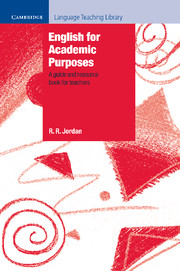Book contents
- Frontmatter
- Contents
- List of figures
- List of abbreviations
- Acknowledgements
- Introduction
- Part I English for Academic Purposes and study skills
- Part II Study skills and practice (EGAP)
- Part III English for Specific Academic Purposes
- Chapter 16 Academic discourse and style
- Chapter 17 Subject-specific language
- Chapter 18 Materials design and production
- Chapter 19 Concerns and research
- Appendices
- References
- Subject index
- Author index
Chapter 18 - Materials design and production
Published online by Cambridge University Press: 10 November 2010
- Frontmatter
- Contents
- List of figures
- List of abbreviations
- Acknowledgements
- Introduction
- Part I English for Academic Purposes and study skills
- Part II Study skills and practice (EGAP)
- Part III English for Specific Academic Purposes
- Chapter 16 Academic discourse and style
- Chapter 17 Subject-specific language
- Chapter 18 Materials design and production
- Chapter 19 Concerns and research
- Appendices
- References
- Subject index
- Author index
Summary
The purpose of this chapter is to consider the desirability and feasibility of teachers producing their own ESAP material for teaching. This may be done because there are no suitable books, or to supplement existing books; there may also be other reasons. First of all, we shall look at differing views on the subject, coupled with advice that has been proffered.
Against and for
One view is expressed by Hutchinson and Waters (1987) who consider that ‘materials writing is best regarded as the last resort, when all other possibilities of providing materials have been exhausted’. Sheldon (1988) also remarks on ‘the sheer labour-intensiveness of developing classroom materials’. Hutchinson and Waters offer a few hints for ‘those who, in the end, feel they have to write new materials’:
a) Don't re-invent the wheel. Use existing materials as a source for ideas.
b) It's better to work in a team, if only to retain your sanity.
c) Don't set out to write the perfect materials on the first draft. Materials can always be improved. Do what you can and try it out. Use what you learn from this experience to revise and expand the materials.
d) Don't underestimate the time needed for materials writing. It can be a very time-consuming business.
e) Pay careful attention to the appearance of your materials. If they look boring and scruffy, they will be treated as such.
f) Good luck!
- Type
- Chapter
- Information
- English for Academic PurposesA Guide and Resource Book for Teachers, pp. 259 - 271Publisher: Cambridge University PressPrint publication year: 1997



